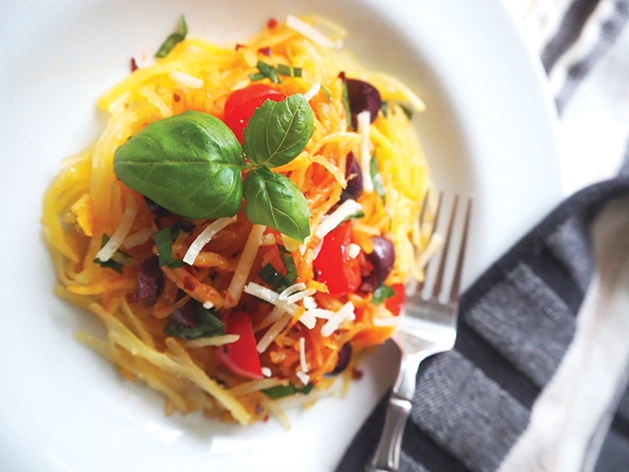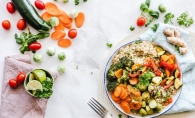
Basil. It’s an herb synonymous with margherita pizza, pesto sauce and caprese. If you’ve ever had an Italian meal, you’ve tasted the sweet balancing herb used as a garnish.
Basil is an easy herb to grow in a kitchen window or right outside the door. We’ve collected some tips from local food experts on how to incorporate the fresh flavor into recipes at home, including a couple meals to try out on a spring evening.
When considering recipes to try, know that the Italian genovese is the most common basil, and what you’ll find at most grocers, according to Michael White, director of culinary operations at Biaggi’s Ristorante Italiano. He’s dealt with seemingly endless amounts of basil, a staple for dishes at the restaurant.
“We probably go through somewhere around 20 pounds of basil a week, maybe 30 depending on the time of year,” White says of the Maple Grove location.
In basil, you’ll find herbaceous and flowery notes, as well as spicy notes like cinnamon, clove and nutmeg, according to White.
When working with basil, especially when it’s of the genovese variety, less is more. It doesn’t need much heat so White tears up fresh basil towards the end of cooking to give dishes an effervescent and flowery flavor.
If you’re looking to get a tad more adventurous in your cooking, try using Thai basil, which has a more developed flavor and gives off the spicy notes of fennel, black pepper and nutmeg. Thai basil lends more to simmering sauces, as the flavor is drawn out over a longer period. If your local grocery store doesn’t carry it, White suggests looking at local farmers markets.
Tomato puttanesca over spaghetti squash
Recipe courtesy of Lunds & Byerlys
Serves 4
Ingredients
1-2 (3 lbs. total) spaghetti squash
6 cups fresh tomatoes, chopped
3 Tbsp. California Olive Ranch Olive Oil
1 cup onion, chopped
2 Tbsp. fresh garlic, minced
2 Tbsp. anchovies, minced
1 tsp. Lunds & Byerlys red pepper flakes
2 Tbsp. capers, drained
1/4 cup Kalamata olives, pitted and chopped
1/8 tsp black pepper, ground
3 Tbsp. (divided) basil, cut into fine ribbons
1/2 cup Parmesan, freshly grated
Directions
Preheat the oven to 450 degrees F. Cut the squash in half and scrape out seeds. Place flesh-side up on an oven tray. Cover with foil and roast for 30 to 40 minutes until fully cooked. Remove from the oven and let cool for 10 minutes. Using a fork, pull apart and set aside.
Puree the tomatoes in a blender or food processor.
Heat 3 tablespoons olive oil in a large skillet over medium heat. Add the onion and cook about 5 minutes. Stir in the garlic, anchovies, red pepper flakes, and capers and fry for 2-3 minutes. Add the tomato puree, olives, black pepper, and 2 tablespoons basil. Bring to a boil and then turn heat to low and simmer, stirring occasionally, until thickened and juice from tomatoes is boiled off, about 15 minutes.
Portion out spaghetti squash and top with sauce. Garnish with remaining basil and Parmesan.
Four Ways to Use Basil
1: Tear basil and toss it in the dish. Tearing leaves opens up more of the cell structure of the leaf to release oils. Add torn basil at the end of the recipe for the best flavor. Improvise and add it to dishes that need more fresh, flowery flavors.
2: Try basil in unexpected places. Salads and craft cocktails are two places where torn basil can shine.
3: Use it to balance sweet and spicy. Michael White, from Biaggi’s, recommends using the herb to offset spicy chilis in Thai and Indian recipes.
4: Grow it on your own. Basil is one of the easiest herbs to grow from seed to plant, and what’s simpler than grabbing basil from your own kitchen garden?
Storing Basil
While Biaggi’s stores basil in a cooler, to regulate the temperature of the herb. At home, basil-enthusiasts can use paper towels to keep their herb vivacious. Michael White advises using a layer of wet paper towel around the herb and another dry layer on top of that so the herb will last longer and hold more flavor. Make sure your basil is protected from varying temperatures by storing it towards the front of the fridge, away from any fans.
Salmon with Lemon, Basil Cream from the Biaggi’s menu
Serves 4
Ingredients
2 Tbsp. shallot, minced
4 Tbsp. white wine, dry
1 lemon, fresh
½ cup heavy cream
4 4-oz. salmon fillets
1 tsp. + 1 pinch sea salt
¼ tsp. white pepper.
1 Tbsp. extra virgin olive oil
12 1-2-inch Genovese basil leaves
Directions
Combine shallot and wine in a small sauce pot over medium-low heat and reduce by 1/3.
Add cream, juice of lemon and pinch of salt. Simmer.
Season salmon fillets with salt and white pepper.
In a non-stick skillet over medium heat, sauté salmon with olive oil. Cook to medium, about 3 minutes per side depending on the thickness. Transfer salmon to plate.
Tear fresh basil leaves in half and add them to the warm cream sauce. Pour warm sauce over fish and serve.
White Bolognese Sauce
Ingredients
1 lbs. Italian sausage
1 lbs. ground sirloin
2 Tbsp. olive oil
2 cups carrots, peeled and diced to ½ inch
1 ½ cups celery, diced to ½ inch
1 ½ cups onions, peeled and diced to ½ inch
1 ½ chili flakes
1 Tbsp. garlic, minced
½ cup Thai basil, de-stemmed and chopped (or substitute ½ cup Genovese Basil + 1 tsp. nutmeg)
1 tsp. kosher salt
1/2 tsp. black pepper, ground
1 cup white wine
1 qt. chicken stock
4 cups kale, de-stemmed and chopped
¼ lbs. Gruyere cheese, grated
Directions
1. In a heavy bottom sauce pot over medium heat, sauté both meats until browned.
2. Add olive oil, diced vegetables, chili flake and minced garlic. Sauté until onions turn translucent, about 7 minutes.
3. Add chopped basil, salt and pepper, sauté for a few minutes longer. Add white wine bring to a boil and reduce by 1/3.
4. Add chicken stock and chopped kale, bring back to a boil. Reduce heat to low, cover and allow to cook for 20 minutes.
5. Finish sauce by stirring in grated Gruyere cheese until completely incorporated.
6. Serve tossed with your favorite short pasta such as Garganelli, Penne or fusilli.









